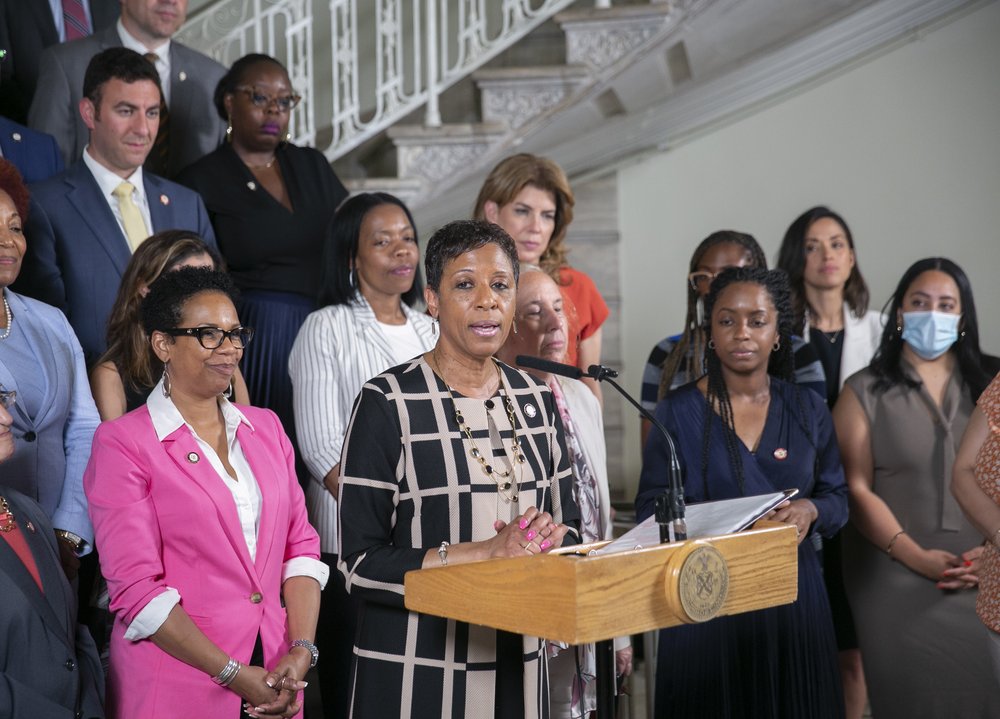NYC Council plans affordable housing targets to spur development in city's wealthier neighborhoods
May 11, 2023, 2:59 p.m.
Legislation introduced by Speaker Adrienne Adams would require the city to set low-income housing goals for every community district.

The City Council on Thursday unveiled a new effort to build and preserve low-income housing in New York City’s wealthier neighborhoods by requiring the city to set specific development targets for all 59 of its community districts.
The “Fair Housing Framework” legislation introduced by Speaker Adrienne Adams comes as New York City is struggling to meet the housing needs of its low- and middle-income residents, with rents reaching record highs and empty, affordable units hard to come by, especially for the poorest New Yorkers.
The speaker’s plan bears similarities to an ambitious housing proposal put forth by Gov. Kathy Hochul earlier this year, which would have set new housing targets for every town in the state and every community district in the city. But unlike Hochul’s proposal, which alienated suburban lawmakers by threatening penalties for missing the mark, the Council-backed plan offers no consequences.
Instead, the bill would create benchmarks for more income-restricted housing, especially in wealthier, predominantly white and transit-rich parts of the city, like the Upper East Side. The legislation defines “affordable housing” as units priced for families of four earning less than $80,000 a year, or individuals making under $56,000.
“The framework will help the city ensure well-resourced neighborhoods that have not equitably contributed to affordable housing production do their fair share,” Adams said. “There has never been inclusivity like this.”
The legislation will force city agencies to conduct housing needs analyses and arrive at the targets by January 2025. The benchmarks could be used to hold councilmembers accountable when considering new development proposals in their districts, though Adams said she was not considering using that information to compel her colleagues.
During the last decade, New York City built roughly 200,000 new housing units while adding around 630,000 new residents and 1 million new jobs. That has put a strain on the city’s housing stock, and the poorest New Yorkers have been feeling the worst effects of the housing crunch.
About a quarter of New Yorkers pay at least 50% of their income on rent — an arrangement the federal government classifies as severely rent-burdened. More than half of New York City renters pay at least a third of their income on housing, according to city data.
A map of income-restricted housing development from 2014 to 2021 lays out the stark disparities in new housing among City Council districts, which overlap with community districts. The affordable housing development totals ranged from 8,550 new housing units in the South Bronx's District 17, which includes Hunts Point and Morrisania, to fewer than 20 new units in northeastern Queens’ District 23, which covers Glen Oaks and Douglaston.
Councilmember Rafael Salamanca, who represents District 17 in the South Bronx and chairs the Council's land use committee, called out the disproportionate rate of housing development and the community districts that have “hardly produced any new affordable housing options at all.”
“The South Bronx cannot build all the affordable housing for New Yorkers,” Salamanca said.
The legislation has support from various tenants rights and affordable housing development advocates, who stood with Adams and several members of the Council at a press conference before a full council meeting.
Rob Solano, the executive director of Churches United For Fair Housing, said his group’s largely low-income and immigrant members are in desperate need of affordable homes.
“They don't pray for miracles. They don't pray for cures of cancer. They pray for just the opportunity for fair housing in New York City,” Solano said.
But efforts to build new affordable housing without consequences for missing development targets have faced sharp criticism. Hochul’s housing plan would have set strict 3% housing goals for New York City community districts and the city’s suburbs, with the state able to step in and approve development if a town missed the mark.
State lawmakers shot down the plan, with some saying the state could fuel new housing development through vague “incentives” instead of penalties.
Attorney Craig Gurian of the Anti-Discrimination Center of New York told WNYC Wednesday that “the ‘pretty please’ method doesn't work.”
Gurian on Thursday praised Adams’ legislation for its citywide focus and explicit effort to address segregation, but said the city should move faster to fuel development in “resistant” communities.
“I like the fact that it’s focusing new construction where it hasn’t been, which should help in fighting racial segregation,” he said. “But you want to leave out this ‘let’s see how they do phase’ and have the city move at a much quicker timeline with specific numeral commitments per community district.”